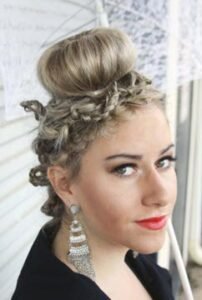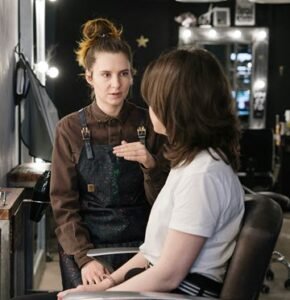Different Types of Hairdressing Services Explained in Detail
When it comes to hairdressing, the variety of services available can be overwhelming. Whether you are a seasoned salon-goer or planning your first visit, understanding the different hairdressing services can help you make informed decisions and achieve the look you desire. This article will explore the various types of hairdressing services, from basic cuts to advanced treatments, ensuring that you leave the salon feeling fabulous.
Haircuts: The Foundation of Hairdressing
Understanding Haircut Styles
Haircuts form the cornerstone of any hairdressing service. The right cut can dramatically change your look, enhancing your features and complementing your style. Here are some popular haircut styles:
 One-Length Cut: This style features hair that is cut to the same length all around, with the front often slightly shorter for framing the face. It gives an illusion of fullness and is ideal for straight hair.
One-Length Cut: This style features hair that is cut to the same length all around, with the front often slightly shorter for framing the face. It gives an illusion of fullness and is ideal for straight hair.- Graduated Cut: This involves cutting the hair at an angle, with the longest strands near the face and gradually shortening towards the back. It adds dimension and is perfect for those seeking a more structured look.
- Layered Cut: Layers are cut into the hair at various lengths, adding depth and volume. This style works well for both thick and thin hair, providing movement and texture.
- Asymmetrical Cut: This bold style features uneven lengths on either side, creating a striking and modern appearance. It is often used to draw attention to specific facial features.
Choosing the Right Cut
Selecting the right haircut involves considering factors such as face shape, hair texture, and personal style. Consulting with a professional stylist can help you identify the most flattering options tailored to your unique characteristics.
Colouring Services: Transforming Your Look
Popular Hair Colour Techniques
 Hair colouring is a popular service that can enhance your appearance and express your personality. Here are some common techniques:
Hair colouring is a popular service that can enhance your appearance and express your personality. Here are some common techniques:
- Balayage: This freehand technique involves painting colour onto the hair to create a natural, sun-kissed effect. It allows for a seamless blend of shades and is low-maintenance.
- Ombré: This method features a gradual transition from a darker shade at the roots to a lighter hue at the tips. It offers a striking contrast and is perfect for those looking for a bold change.
- Highlights and Lowlights: Highlights add lightness to specific sections of hair, while lowlights introduce darker shades for depth. Both techniques can create dimension and interest.
The Colouring Process
The colouring process typically involves consultations to determine the desired outcome, followed by the application of the chosen products. Professional colourists can help you navigate the vast array of options and recommend the best techniques for your hair type.
Styling Services: Elevating Your Look
Everyday Styling
Styling services are essential for achieving a polished look. These can include:
- Blow-Dry: A blow-dry service involves drying the hair with a round brush to create volume and smoothness. It is a quick way to achieve a salon-fresh appearance.
- Updos: Updos are perfect for special occasions, offering elegant styles that keep hair off the face. From simple buns to intricate braids, there are countless options to choose from.
Special Occasion Styling
 For events like weddings or parties, many salons offer specialised styling services. These may include elaborate updos, curls, or other creative styles that require extra time and expertise.
For events like weddings or parties, many salons offer specialised styling services. These may include elaborate updos, curls, or other creative styles that require extra time and expertise.
Texture Services: Adding Volume and Movement
Perms and Relaxers
Texture services help to modify the natural texture of your hair. Popular options include:
- Perms: This chemical treatment adds curls or waves to straight hair, providing long-lasting texture. Different types of perms can create varying curl sizes and effects.
- Relaxers: For those with naturally curly hair, relaxers can help to straighten and soften the hair, making it more manageable. This service is ideal for individuals seeking smoother locks.
Smoothing Treatments
Smoothing treatments, such as keratin treatments, help to reduce frizz and enhance shine. They can significantly improve the overall health and appearance of your hair, making it easier to style.
Express Services: Quick Solutions for Busy Clients
The Rise of Express Treatments
In today’s fast-paced world, many salons are incorporating express services that take 30 minutes or less. These quick treatments cater to clients looking for efficient solutions without compromising quality. Some popular express services include:
- Volumizing Treatments: These treatments use special products to lift the roots and add body to flat hair, providing instant volume.
- Express Updos: Ideal for those short on time, express updos can be done quickly, allowing clients to achieve a polished look without a lengthy appointment.
- Healthy Scalp Treatments: Focusing on the scalp’s health can improve overall hair quality. Express treatments may involve clarifying shampoos and conditioning massages to rejuvenate the scalp.
Treatments and Masks: Nourishing Your Hair
The Importance of Hair Treatments
Hair treatments are essential for maintaining the health and vitality of your locks. They can address various concerns, such as dryness, damage, and colour fading. Here are some common treatments:
- Hydrating Masks: These masks provide intense moisture to dry hair, restoring shine and softness. They can be incorporated into regular salon visits for optimal results.
- Protein Treatments: Strengthening treatments help to repair damaged hair by replenishing lost proteins. They are especially beneficial for those with chemically treated or heat-damaged hair.
Incorporating Treatments into Your Routine
Many salons offer treatments as add-ons to regular services, allowing clients to maximise their salon experience. Discussing your hair concerns with your stylist can help you determine the best treatments for your needs.
Understanding Hair Salon Terminology

Key Terms to Know
Familiarising yourself with common hair salon terminology can enhance your communication with your stylist. Here are some essential terms:
- Toner: This product is used after lightening to neutralise unwanted undertones and achieve the desired shade.
- Creative Colour: This refers to non-traditional hair colours, such as pastels or vibrant shades, allowing for unique self-expression.
- Colour Correction: If previous colour treatments have gone awry, colour correction services can help to rectify the situation, often requiring multiple appointments.
The Role of Hair Professionals
Types of Hairdressing Professionals
Understanding the different roles within a salon can help you choose the right stylist for your needs. Here are some common positions:
- Stylist: A stylist is responsible for cutting and styling hair, offering personalised services based on client preferences.
- Colourist: Specialising in hair colour, colourists are trained to create beautiful shades and manage colour corrections.
- Senior Stylist: With more experience, senior stylists offer advanced techniques and can handle complex requests.
The Importance of Consultation
Preparing for Your Appointment
A thorough consultation is crucial for achieving the desired results. During your appointment, your stylist will discuss your preferences, lifestyle, and hair type to recommend suitable services. This ensures that you receive personalised care tailored to your needs.
Questions to Ask
Consider asking your stylist the following questions during your consultation:
- What styles or colours would suit my face shape and skin tone?
- How much maintenance will this style require?
- Are there any treatments or products you recommend for my hair type?
Maintaining Your Look
Home Care Tips
Once you’ve achieved your desired look, it’s essential to maintain it. Here are some tips for keeping your hair healthy between salon visits:
- Use Professional Products: Investing in salon-quality products can help maintain your colour and style, ensuring long-lasting results.
- Regular Trims: Scheduling regular trims can prevent split ends and keep your hair looking fresh.
- Protect from Heat: Using heat protectants before styling can help minimise damage from hot tools.
Scheduling Follow-Up Appointments
Maintaining communication with your stylist is key. Regular follow-up appointments will ensure that your hair remains in top condition, allowing you to make adjustments as needed.
Conclusion
Understanding the various types of hairdressing services available empowers you to make informed choices about your hair. From haircuts and colouring to styling and treatments, each service plays a vital role in achieving your desired look. By familiarising yourself with salon terminology and the roles of hair professionals, you can enhance your salon experience and leave feeling confident and beautiful.
Whether you’re preparing for a special occasion or simply treating yourself to a new style, your journey to fabulous hair starts with knowledge and communication. So, embrace the world of hairdressing and discover the endless possibilities that await you!
We hope you enjoyed our Article on Different Types of Hairdressing Services
Please Click Here To Return To Home Page